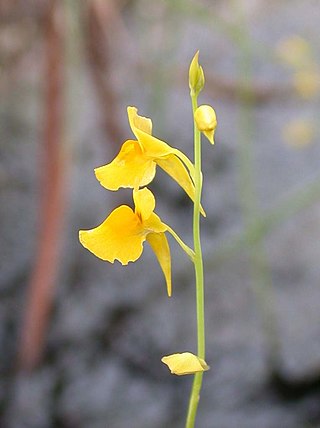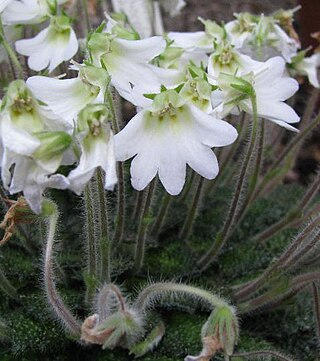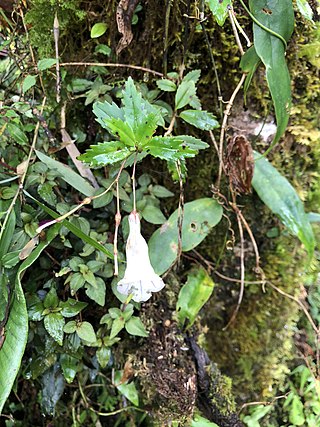
Gesneriaceae, the gesneriad family, is a family of flowering plants consisting of about 152 genera and ca. 3,540 species in the tropics and subtropics of the Old World and the New World, with a very small number extending to temperate areas. Many species have colorful and showy flowers and are cultivated as ornamental plants.
Breviea is a genus of plant in the family Sapotaceae described in 1935.
Gluema is a genus of plant in family Sapotaceae described as a genus in 1935.
Placodiscus bancoensis is a species of plant in the family Sapindaceae. It is found in Ivory Coast and Ghana. It is threatened by habitat loss.
Synsepalum aubrevillei is a species of plant in the family Sapotaceae. It is found in Côte d'Ivoire and Ghana in wet, tropical biomes, and is threatened by habitat loss.

Utricularia odorata is a medium-sized, probably perennial carnivorous plant that belongs to the genus Utricularia. It is native to southeastern Asia and northern Australia. U. odorata grows as a terrestrial plant in wet grasslands at low altitudes. It was originally described by François Pellegrin in 1920. The specific epithet odorata is derived from reports that the flowers are fragrant.

Petrocosmea is a genus of the family Gesneriaceae, the African violet family. Many of the species within this genus are endemic to high-elevation areas in Western China, although some are native to other parts of Asia. including north-central and southern China, Indochina, and the eastern Himalayas. It is a rosette-forming genus that generally grows on wet mossy rocks or forests.

Primulina is a genus of flowering plants in the African violet family Gesneriaceae. In 2011 the genus was expanded with the transfer of many species that had previously been placed in the genus Chirita. In 2016, five species were moved to the genus Deinostigma.

Microchirita is a genus of flowering plants in the family Gesneriaceae, subfamily Didymocarpoideae. It contains 48 species native to tropical Asia, ranging from the Indian subcontinent to Indochina, southern China, and Malesia.

Lysionotus is a genus of flowering plants in the family Gesneriaceae. It occurs in the Himalayas, China, Japan, and Southeast Asia. The genus was described by David Don in 1822.
André Aubréville was a French botanist, professor at the National Museum of Natural History in Paris and a member of the Academy of Sciences. He was the first scientist to introduce the term "desertification" (in his 1949 book: Climats, forêts et désertification de l'Afrique tropicale, and wrote a number of floras of former French colonies.
François Pellegrin was a French botanist, who specialised in the plants of tropical Africa.

Dorcoceras is a genus of flowering plants in the African violet family Gesneriaceae, native to Assam, Southeast Asia, China and central Malesia. Its species were transferred from the genus Boea in 2016.
Whytockia is a genus of flowering plants belonging to the family Gesneriaceae.
Beccarinda is a genus of flowering plants belonging to the family Gesneriaceae.
Petrocodon is a genus of the family Gesneriaceae. It includes 51 species native to southern China and Indochina. Petrocodon formerly had few species, but recent genetic analysis has refined our understanding of the genus. Calcareoboea, Paralagarosolen, Dolicholoma, and Tengia monotypic genera have been transferred to Petrocodon, as well as some Didymocarpus and Lagarosolen species.

Hemiboea is a genus of flowering plants belonging to the family Gesneriaceae.
Loxostigma is a genus of flowering plants belonging to the family Gesneriaceae.

Metapetrocosmea is a genus of flowering plants belonging to the family Gesneriaceae. It includes ten species native to southern China, Hainan, and Vietnam.
Raphiocarpus is a genus of flowering plants belonging to the family Gesneriaceae.









